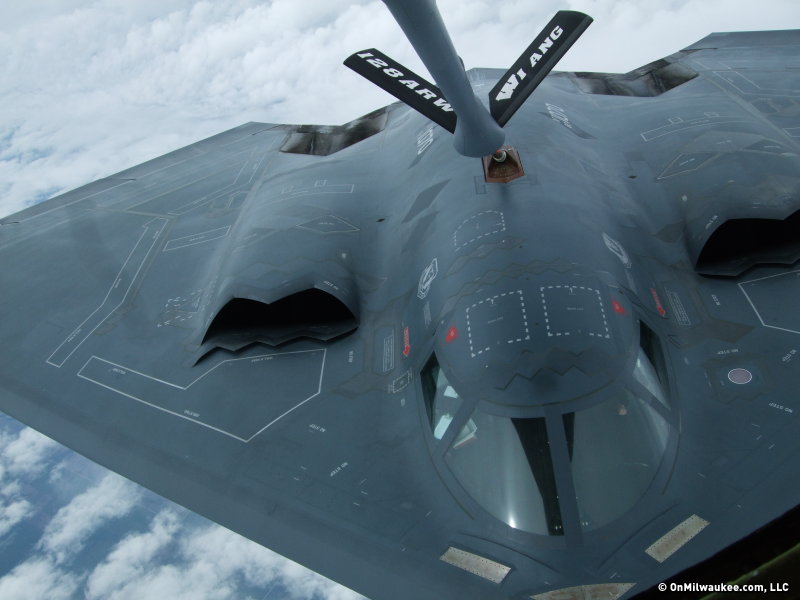It's not every day that I wake up in Milwaukee, fly over Iowa and Missouri, then touch back down at the same airport three hours later. Of course, it's not every day, either, that I'm a guest on a Wisconsin Air National Guard KC-135R Stratotanker, where the mission it is to refill a B-2 Stealth Bomber at 38,000 feet.
Armed Forces Week starts Friday, and the 128th Air Refueling Wing invited me to join them on a training mission this morning. Needless to say, it turned out to be one of the most thrilling experiences of my life.
I really didn't know what to expect when I arrived at the base on the east side of Gen. Mitchell International Airport at 7 a.m. for my briefing. Surprisingly, only two other reporters showed up for the event, so we got a ton of personal attention. By the time we boarded the circa 1962 vintage modified Boeing 707, we had learned about evacuation procedures and how to operate the FPOS, the personal oxygen system on board if hell went to a hand basket mid-flight.
The 128th Air Refueling Wing's mission is an interesting one. Among its many duties, its 882 members pilot and service the "flying gas stations" to the Air Force and the Air National Guard -- providing support to all sorts of planes from B-52s to F-16s to B-2 Stealth Bombers. I was lucky, they told me, that we were selected to refuel the stealth bomber, a plane that's cool to see at an air show on the ground, but spectacular to see streaking through the air from 10 feet away.
The Stratotanker, itself, was nothing to get excited about. Loud, a little smelly and not especially comfortable -- equipped with jump seats along both sides -- the drab gray tanker is all about substance, not style.
While the U.S. military has kept the KC-135R in excellent flying condition, it does lack some basic amenities. For example, the pilot doesn't have any sort of back-up camera, for lack of a better term, so he never sees the plane refueling behind him and has to rely on the intercom from the boom operator and the other plane. The Stratotanker also doesn't have reverse thrusters and instead relies on brakes to bring it to a stop (more on that later). And the plane is irregularly heated, too: the cockpit was chilly while the back was toasty. It's understandable, though, as the military has more important things to do than deliver its cargo or its jet fuel in luxury.
Taking off in the refueling plane involves much less rigmarole than what you find in a commercial airliner. The pilot gave one blast of the warning horn, and away we went -- way faster and steeper than what I'm used to.
We had about an hour until arriving at the meeting point for the start of the exercise, so I had plenty of time to talk to all of the dozen or so people on the plane. The three boom operators are each in their 20s; two women and one man. All three were quick to talk about their job and why they love it: despite the dangers of combat in an unarmed, flying gas tank, it's thrilling, secure work and it provides them a chance to see the world. The team I met this morning had already been stationed in Germany, Qatar and Turkey, and plans to do this for their entire career.
As the rendezvous time with the bomber approached, I followed Sgt. Lynda Matthews to the rear of the KC-135, where she took her position, face down, staring out the back of the plane. I slid up on a cushion next to her as the fueling rod extended from our plane, and then I watched a stealth bomber seemingly appear out of nowhere. I was wearing headphones, so I could hear -- though not understand -- all of the radio chatter, but I heard air traffic control and the pilots discuss some dicey weather ahead.
The scene looked exactly how I imagined it would, but the awesome experience of seeing it first-hand is hard to explain. The bomber, which was floating a few hundred feet away, instantly took its place 50 feet below the KC-135, call sign "Upset." On Matthews' command, "Death," pulled closer, eventually a mere 10 feet from my face.
Keep in mind that were both traveling at 400 miles per hour, some 30,000 feet above Iowa or Missouri. From my view, I could see the bomber pilot's face, his clipboard and the notes on his dashboard. The two planes traveled in perfect harmony, and Matthews directed the boom by joystick. Then, in what looked like an insect mating ritual, the boom locked onto "Death" and began pumping it full of fuel. "Upset" repeated the exercise several times, as the other two boom operators took turns.
As the third boom operator finished the fueling operation, I took a seat behind the pilots in the cockpit. Both the pilot and the co-pilot were top-notch, flight instructor grade aviators. Today's co-pilot is a full-time Air National Guardsman, while the pilot does his military service part-time and is a commercial 767 pilot the rest of the year.
To conclude this training mission, the planes took part in a simulated "break off," the maneuver that separates the planes quickly in the event that something goes wrong. I was sitting in the cockpit when the order came down, and the pilot really punched it, throwing me back into my seat just a little. Then, the mission was over, and we turned around, passing Joliet, zigzagging around O'Hare and eventually heading northwest back to Mitchell.
I spent the rest of the flight in the cockpit, really watching the pilots with a watchful eye. They must've have noticed that I was intrigued by all the dial fiddling, and the pilot told me that the military "is big into fuel conservation." In the old days, he said, they'd fly around at full speed with little regard for saving gas; now they are much more mindful.
Flying with this team, too, put my mind at ease about air travel in general. I've never avoided flying, but the lack of control always leaves me feeling about one second from death on every trip. But sitting behind pilots, listening to air traffic control, and seeing them change altitude, trim and move the position of the flaps, it all felt so much more logical. Usually I find myself somewhat drenched in sweat while flying; today's mission, while certainly more dangerous, felt safe and secure throughout. The skill and professionalism of this entire crew was nothing short of amazing.
Finally, we banked over Lake Michigan and landed on the Mitchell's east-west runway. Touchdown was smooth, but with no reverse thrusters, the pilots had to use the KC-135's brakes to slow the plane -- quite a different feeling, but not an unpleasant one, than what you get flying coach.
And then it was over. This morning turned into a visual reminder of why Armed Forces Week is actually an important occasion. Regardless of what you think of the military's missions, one can't deny that the people behind them serve both bravely and professionally, and that Milwaukee plays a crucial part in keeping America's planes in the air.
Unfortunately, not all of the participants in this weekend's events will have the opportunity to go on a refueling flight like I did, but at least visitors can see 30 aircraft on display at 128th Air Refueling Wing. If you're into that kind of stuff, or just want to show support for the men and women who serve our country, make sure to check it out.
Andy is the president, publisher and founder of OnMilwaukee. He returned to Milwaukee in 1996 after living on the East Coast for nine years, where he wrote for The Dallas Morning News Washington Bureau and worked in the White House Office of Communications. He was also Associate Editor of The GW Hatchet, his college newspaper at The George Washington University.
Before launching OnMilwaukee.com in 1998 at age 23, he worked in public relations for two Milwaukee firms, most of the time daydreaming about starting his own publication.
Hobbies include running when he finds the time, fixing the rust on his '75 MGB, mowing the lawn at his cottage in the Northwoods, and making an annual pilgrimage to Phoenix for Brewers Spring Training.



